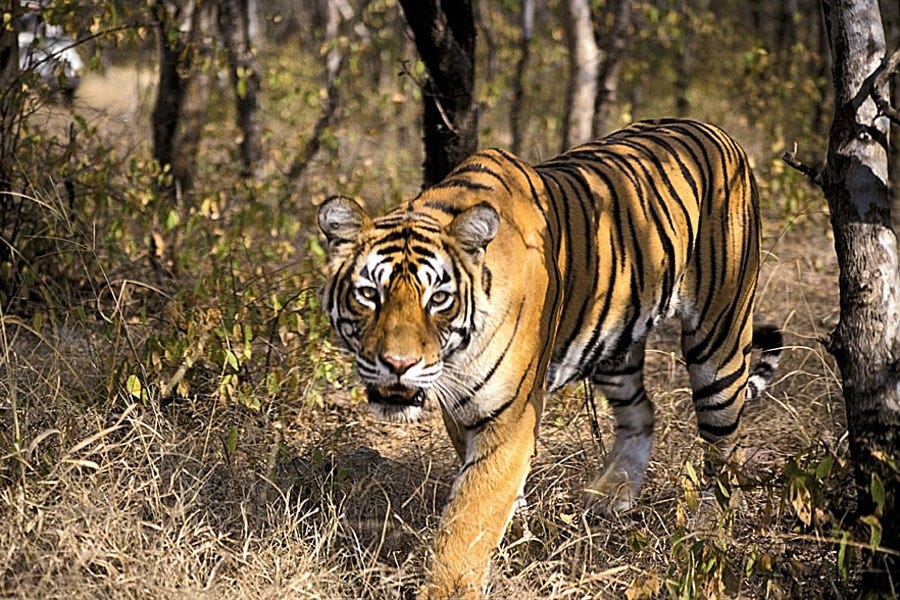1. Gangotri National Park
Among the few high altitude national parks in India, located in Uttarkashi, of Indian state Uttarakhand. The key feature of this national park is ‘Gangotri’ — the glacier that marks the origin of Ganga. The river Bhagirathi originates from this glacier and flows through the valleys inside the park, nourishing the life in this region.

Image Source: travelhi5.com
Gangotri National Park is the home of the rarest specimens of fauna within its boundaries. Some of these animals have evolved to be accustomed to the cold and harsh environments that engulf some of its regions. Black bear, snow leopard, musk deer, brown bear, Himalayan tahr, blue sheep, Koklass, Himalayan monal, ibex, barbet, Himalayan snowcock, pheasants, pigeons, serow, doves, partridges, etc.
2. Silent Valley National Park
Moving from the glaciers to the rainforest, Silent Valley National Park. It springs some of the amazing life forms. The Valley exudes a quite grandeur, a mystery half revealed and half concealed that is part of a story older than mankind, for this rainforest probably dates back to 50 million years.
Silent Valley is a virgin, fragile forest, nestled in the mountain folds of the Nilgiris in Southern India. This rainforest is great place to trek but, only serious trekkers find their way to Silent Valley, as trekking in this undulating terrain with thick vegetation is no cakewalk.

Image Source: Wikipedia
Silent Valley is situated in the northeastern part of Palakkad district, Kerala. The nearest town is Mannarkkad (66Km).
3. Balpakram National Park
Far in the north east of India, explore the mysterious sanctuary in Meghalaya. ‘Land of Spirits’ is the popular name of Balapakram National Park. It is vast tableland of dense forest, teeming wildlife and quite an unknown rich bio diversity spot in India. it is a home many rare and exotic species of fauna, some endemic to the area, many almost extinct, evokes interest among wildlife enthusiasts. A place to be loved by the wildlife photographers.

Image Source: sanctuariesindia.com
The Garo tribes revere it as a sacred place, so far the aspect of mystery is still remained unsolved. The legendary ape-like creature called mande barung is similar to Yeti of Tibet. The rarest animal species found here are Red Panda, Wild water Buffalo, Golden Cat, stump-tailed macaque and others that will introduce to the wild diversity of India.
4. Nagarhole National Park
Nagarahole is named after Nagarahole (Cobra river in the local language, Kannada), a winding river which runs eastwards through its centre.
The Nagarhole ecosystem supports the highest density of herbivores anywhere in Asia with around 108 animals per sq km. In addition to large herbivores such as the Chital, Sambar, Gaur, Asian Elephant and more, Nagarhole also boasts a large number of predators including the Tiger, Leopard and Wild dog.

Image Source: www.traveldglobe.com
The largest congregation of Asian Elephants in the world is the highlight of Nagarhole National Park is the , which occur during the summer months. The park can remain closed for long stretches between July and October, when the rains transform the forests into a giant slush-pit.
5. Valley of Flowers
The utter beautiful, Valley of Flowers is a vibrant and splendid national park reposing in West Himalayas. Nestled in Uttarakhand, this alluring place is famous for its charming meadows of alpine flowers. Endowed with a diverse range of endemic flora, it is picturesque in its beauty. This lush region is also home to some rare and endangered animal species.
The virgin beauty of this mystical valley has always lured botanists, nature lovers and adventure lovers. It is counted as one of the UNESCO world heritage sites.

Image Source: MumbaiTravellers.in
Valley of Flowers remains covered with a thick blanket of snow during the winter season. It is in full bloom during July, August and September, so post monsoon is the best time to visit Valley of Flowers. However, after the floods 2 years back it was closed and supposed to reopen this summer.
6. Kanger Valley National Park
In the land of surprises, here lies the most beautiful and picturesque national park of India. The flora in the park chiefly comprises of mixed moist deciduous type of forests with predominance of Sal, Teak and Bamboo trees. In fact, the Kanger Valley is the only region in the Peninsular India where one of the last pockets of virgin and untouched forests still left.
Major Wildlife of the Kanger Valley National Park are the Tigers, Leopards, Mouse Deer, Barking Deer, Rhesus Macaque, Sloth Bear, Flying Squirrel, Wild Boar, Striped Hyena, Pythons, Cobra. Some 4km from the park entrance are Tirathgarh Falls, where water drops 100m through three sets of cascades. Open all year, they’re best visited after the monsoon.

Image Source: IndiaGateways.co.in
Kanger Valley is well approachable from Jagdalpur, district head quarter of Bastar. It is at a distance of about 27 km from Jagdalpur.
7. Great Himalayan National Park
Surrounded on three sides by towering Himalayan Mountains, the Great Himalayan National Park (GHNP) hosts some of the densest population of Himalayan wildlife species. It is acknowledged as a UNESCO world heritage site.
The fauna of the park includes some of the most exotic species of animals like snow leopard, blue sheep, Himalayan brown bear, Himalayan tahr, musk deer, goral and many others. It is also home to the endangered species of western tragopan and over 50 species of migratory birds.

Image Source: PhotoBucket.com
The park is also famous destination with trekkers. Neuli- Sarangarh loop, Neuli- Sainj valley, Sainj- Tirthan valley, Gushaini-Tinder village, Gushaini- Shilt Hut, Neuli-Manu temple, Siund- Pashi villages, Jiwa Nala- Parvati River valley, Gushaini- Tirthan valley and Shamshi- Kaza are some of the famous trail.
Get your backpack ready and start the wildlife exploration. It will connect you to the nature, moreover, that experience will enchant the spirituality in you.
“The clearest way into the Universe is through a forest wilderness.”
― John Muir
